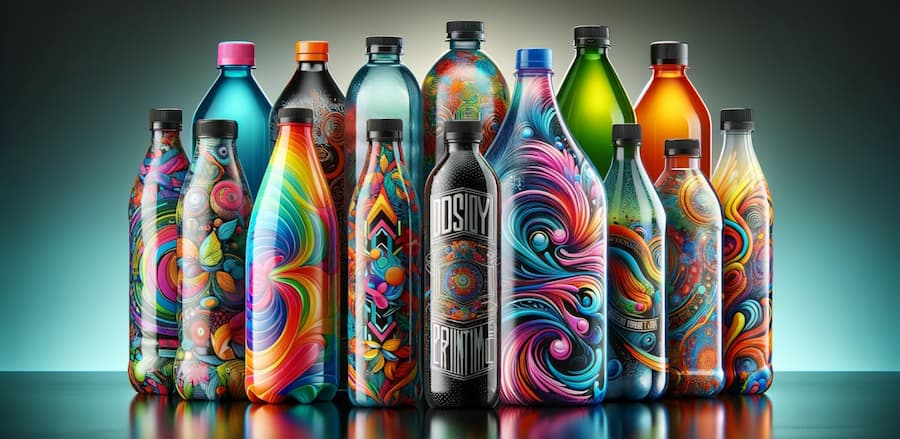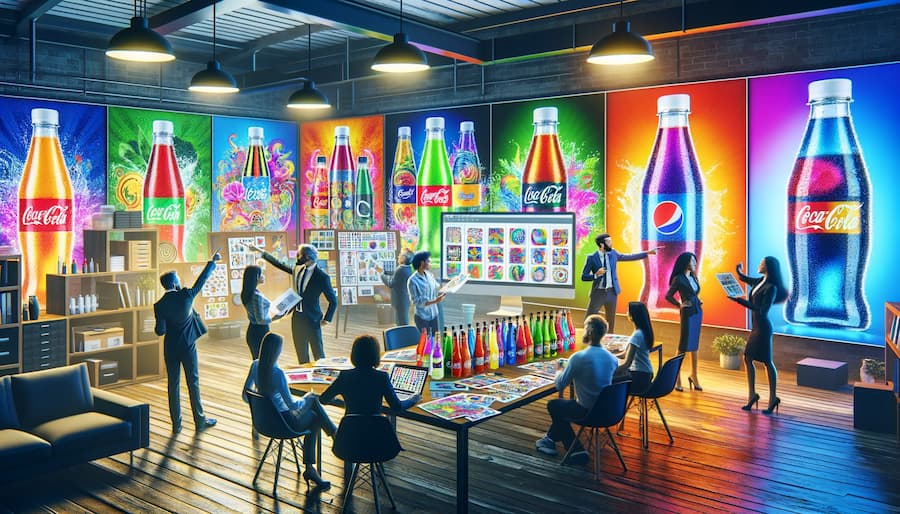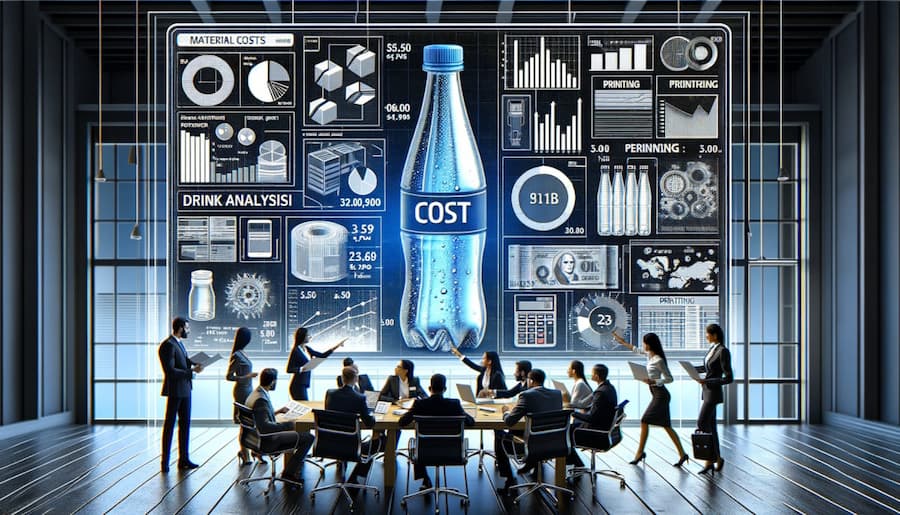
20 May, 2024
The Beauty of Full-Colour Digital Printing on Drink Bottles
In the realm of marketing and product design, the technique of full-colour digital printing on drink bottles has emerged as a revolutionary approach. This technology not only enhances aesthetic appeal but also opens new avenues for branding and customer engagement. Today we will look into the intricacies of full-colour digital printing, exploring the types of bottles suitable for this method and how companies can leverage it for greater impact.
Understanding Full-Colour Digital Printing
It is a process that applies photographic quality images, intricate designs, and a wide spectrum of colours directly onto the surface of a bottle. Unlike traditional methods, which often use labels, screens or pads, this technique prints directly onto the bottle. It employs advanced inkjet technology, where tiny droplets of ink are precisely placed on the bottle's surface, creating high-resolution images.
The Process
1. Preparation
- Cleaning: The bottle surfaces are thoroughly cleaned to remove dust, grease, or any contaminants. This is crucial as any residue can hinder ink adhesion.
- Surface Treatment: Depending on the material of the bottle (glass, plastic, metal), a specific treatment may be applied to improve ink adherence. For instance, a corona treatment is often used for plastics, which involves exposing the surface to a high-frequency electrical discharge to increase surface energy.
- Primer Application: Sometimes, a primer is applied to create a more receptive surface for the ink. This is especially important for materials like glass or certain plastics, where ink adhesion might be challenging.
2. Artwork Creation
- Design Development: Artists or graphic designers develop the artwork, considering the bottle's shape and texture. This ensures that the design aligns correctly and looks appealing on the curved surface.
- Digital Adaptation: The artwork is then adapted for digital printing. This involves converting the design into a digital format that can be read by the printing software, often requiring specific file formats and resolutions.
- Mock-ups and Proofs: Before actual printing, digital mock-ups or proofs may be created to preview how the design will look on the bottle. This allows for any necessary adjustments before the final printing.
3. Colour Management
- Colour Matching: Ensuring that the printed colours match the original digital design is critical. This involves colour calibration and profiling, which aligns the printer's output with the desired colours.
- Software Integration: Advanced software is used for colour management, translating the colours from the digital design into an accurate representation on the bottle.
- Testing: Test prints are often conducted to fine-tune the colour output, ensuring consistency and accuracy.
4. Printing
- Inkjet Technology: Specialised inkjet printers equipped with high-precision nozzles are used. These printers can handle different bottle sizes and shapes.
- Ink Type: The type of ink used varies based on the material of the bottle. UV-curable inks are common due to their quick curing properties and durability.
- Efficiency: Digital printing allows for rapid production. The design can be printed in a single pass, which is much faster compared to traditional screen printing.
5. Curing
- UV Curing: The most common method is UV curing, where the printed ink is exposed to ultraviolet light. This process rapidly dries and hardens the ink, making it durable and resistant to wear.
- Heat Curing: Sometimes, especially with certain types of inks and materials, heat curing is used. This involves heating the bottle to a specific temperature to set the ink.
Each of these steps plays a vital role in ensuring that the final product – a digitally printed drink bottle – is not only visually striking but also durable and of high quality. The advancements in this technology have made this process increasingly efficient, allowing for greater creativity and flexibility in bottle design.
Suitable Bottle Types

Full-colour digital printing is versatile, accommodating a range of bottle materials, including:
1. Glass Bottles
- Characteristics: Glass provides a premium, high-quality look and feel. It's non-porous and offers a smooth surface, ideal for high-resolution printing.
- Printing Adaptability: It can handle complex, vibrant designs and is suitable for detailed artwork. However, it requires careful handling during the printing process.
- Surface Treatment: Glass often needs specific treatment to enhance ink adhesion, such as a primer or a special coating.
- Usage: Commonly used for luxury beverages, spirits, and limited-edition products. They can elevate the perceived value and aesthetic appeal of the product.
2. Plastic Bottles
- Types: The most suitable plastics for digital printing are PET (Polyethylene Terephthalate) and HDPE (High-Density Polyethylene).
- PET Characteristics: PET is clear, strong, and lightweight. It's ideal for single-use bottles and is widely used in the beverage industry. PET allows for vibrant and clear printing results.
- HDPE Characteristics: HDPE is more flexible and resilient, often used for bottles that need to withstand squeezing, like condiment or lotion bottles. It has a slightly less clear appearance but holds ink well.
- Surface Treatment: They may require treatments like flame or corona treatment to increase surface energy for better ink adhesion.
- Versatility: They offer a wide range of shapes and sizes, allowing for creative design opportunities.
3. Metal Bottles
- Aluminium: The primary metal used in bottle printing is aluminium, known for its lightweight and durable properties.
- Surface Preparation: Aluminium drink bottles often require an anodized surface to enhance ink adhesion. Anodizing creates a porous surface on the aluminium, allowing the ink to bond more effectively.
- Durability: Aluminium is robust and resistant to corrosion, making it suitable for sports and energy drinks that might be subjected to rough handling.
- Thermal Properties: It has excellent thermal properties, keeping beverages cool, which is a desirable feature for certain drink categories.
- Recyclability: They are highly recyclable, adding an eco-friendly aspect to their use in packaging.
Each of these materials offers unique advantages and challenges. The choice of bottle material is often influenced by the product type, brand image, and intended market segment. The technology has advanced to effectively accommodate these different materials, allowing brands to fully use the potential of each to create striking and memorable packaging.
Applications in Marketing and Branding

1. Brand Differentiation:
- Impact on Shelf Appeal: In a competitive retail environment, unique and eye-catching designs on drink bottles can significantly enhance shelf appeal, making products more noticeable and attractive to consumers.
- Customisation and Creativity: The printing allows for high levels of customisation. Brands can experiment with intricate, bold designs, or even photographic quality images to make their products stand out.
- Consistency Across Products: This printing method ensures consistency in branding across various product lines, as it precisely replicates colours and designs, maintaining brand identity.
2. Targeted Campaigns:
- Limited Edition Designs: Brands can create limited edition designs for special occasions, seasons, or events. This not only appeals to collectors but also creates a sense of urgency and exclusivity.
- Demographic-Specific Messaging: Digital printing facilitates the creation of targeted messaging aimed at specific demographic groups, enhancing relevance and appeal to those segments.
- Regional Customisation: Companies can tailor designs to suit regional preferences or cultural themes, thereby resonating more deeply with local markets.
3. Sustainability Appeal:
- Reducing Label Waste: Direct printing on bottles eliminates the need for separate labels, reducing waste from label backing papers and adhesives.
- Energy Efficiency: Modern printing processes can be more energy-efficient compared to traditional printing methods, contributing to a lower environmental footprint.
- Perception and Brand Image: Using a more sustainable packaging method can enhance a brand's image among environmentally conscious consumers, aligning with the growing trend towards sustainability in consumer choices.
4. Interactive Elements:
- QR Codes: By integrating QR codes into the designs, companies can direct consumers to websites, promotional content, or digital experiences. This not only enhances engagement but also provides a platform for further marketing and consumer interaction.
- Augmented Reality (AR): Incorporating AR elements can create immersive experiences. For instance, when scanned with a smartphone, the bottle could display interactive content, tell a story, or offer a virtual product demonstration.
- Data Collection and Personalisation: Interactive features can also be a tool for data collection and consumer insights. Engagement with QR codes or AR features can provide valuable data on consumer preferences and behaviours, which can be used to tailor future marketing strategies.
Companies Leveraging Full-Colour Printing
Full-colour digital printing on drink bottles offers diverse applications for various types of companies, each leveraging this technology to enhance their branding and market appeal:
1. Soft Drink Manufacturers: These companies can use vivid, colourful designs to make their products more attractive, especially for limited-edition flavours or special collaborations.
2. Craft Brewery and Wineries: Small-scale breweries and wineries can differentiate their products with unique artwork, telling a story or highlighting the artisanal nature of their beverages.
3. Health and Fitness Brands: Companies selling sports drinks or health beverages can use dynamic designs to appeal to fitness enthusiasts, incorporating elements that resonate with an active lifestyle.
4. Dairy Producers: Milk or dairy-based drink manufacturers can utilise it to create appealing packaging for children and adults, highlighting the natural ingredients or health benefits.
5. Specialty Tea and Coffee Producers: These businesses can feature origin-specific imagery or limited-edition designs to showcase the uniqueness of their blends.
6. Juice Companies: Can leverage vibrant, fruit-themed designs to reflect the freshness and natural quality of their products, appealing to health-conscious consumers.
7. Energy Drink Brands: Often targeting a younger, dynamic audience, these companies can use bold and edgy designs to reflect the energetic nature of their products.
8. Mineral Water Suppliers: High-end mineral water brands can use elegant, minimalist designs to convey purity and luxury, appealing to a premium market segment.
9. Nutritional Supplement Brands: These companies can use clear, informative designs for their drinkable supplements, making them appealing and easy to understand for consumers focused on health and wellness.
10. Flavoured Water Brands: Can use playful and colourful designs to make their products stand out and appeal to a broad audience, including families and health-conscious individuals.
Each type of company can tailor it to their specific branding needs, creating packaging that not only attracts attention but also resonates with their target audience. This technology allows for high levels of customisation, making it possible to develop unique packaging solutions that can significantly enhance market presence and consumer appeal.
Challenges and Considerations

1. Cost
- Initial Investment: The upfront cost for full-colour digital printing technology is typically higher than for traditional printing methods. This includes the cost of advanced printers and specialised inks.
- Economies of Scale: It may not be as cost-effective for small production runs. While it eliminates the need for printing plates (used in traditional methods), the cost per unit can be higher for smaller quantities.
- Ink and Maintenance Costs: The inks used, especially UV-curable inks, can be expensive. Additionally, maintaining and servicing high-tech digital printers can add to the overall cost.
- Cost-Benefit Analysis: Companies need to weigh the benefits of superior customisation and print quality against these higher costs. For brands where differentiation is key, the investment can be justified.
2. Durability
- Ink Adhesion: One of the primary concerns is ensuring that the ink adheres well to the bottle material, whether it's glass, plastic, or metal. Poor adhesion can lead to smudging or fading.
- Environmental Resistance: Bottles are often exposed to various environments – sunlight, moisture, handling – which can affect print longevity. Ensuring that the print can withstand these conditions is crucial.
- Curing Process: The effectiveness of the curing process (UV or heat curing) plays a significant role in durability. Properly cured ink is more resistant to external factors.
- Protective Coatings: Sometimes, an additional protective coating may be applied over the print to enhance durability, especially for products that are handled frequently.
3. Design Constraints
- Bottle Shape and Size: The curvature, edges, and contours of the bottle can limit the printable area. Extremely curved or irregularly shaped bottles may pose challenges for even ink application.
- Material Constraints: Different materials (glass, plastic, metal) have different surface properties, which can affect how designs are printed. For instance, certain intricate designs might not render well on textured surfaces.
- Colour Limitations: While digital printing offers a wide colour palette, there can be limitations in reproducing certain hues accurately, especially on transparent or coloured bottles.
- Resolution and Detail: The resolution achievable by the printer determines how detailed the design can be. Fine details may not always be replicated perfectly, particularly on smaller bottles.
These challenges necessitate careful planning and expertise in digital printing. Companies need to consider these factors to ensure that the final product meets their quality standards and fulfils the intended marketing objectives.
Conclusion
Full-colour digital printing on drink bottles represents a significant advancement in packaging technology. Its ability to deliver stunning, durable designs directly onto a variety of bottle materials makes it an invaluable tool for marketers and product designers. As the technology continues to evolve, its accessibility and applications are likely to expand, further transforming the landscape of product packaging and branding.
The Drink Bottles Team
